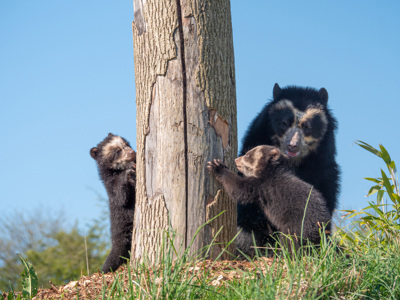
Conservation at Noah's Ark
The Role of Noah’s Ark Zoo Farm within European Breeding Programmes
Throughout the last two hundred years, the role of zoos has changed dramatically. Starting out in the 19th century as scientific menageries, zoos showcased a variety of previously undiscovered species from around the world, with little consideration for conservation or welfare. Now of course, the role of zoos is much different. Conservation, education and research form the foundations on which all modern and progressive zoos build their objectives, and Noah’s Ark is no exception.

At Noah’s Ark we are currently participating in four EEP’s (European Endangered Species Programmes) and two ESB’s (European Studbooks). These breeding programmes are coordinated by EAZA (European Association of Zoos and Aquaria) and aim to conserve genetically healthy populations of animals in captivity, in an effort to safeguard populations in the wild. As official non-EAZA EEP participants, Noah’s Ark is proud to play its part in helping zoos across Europe and the rest of the world to conserve rare and endangered species.

EEPs (European Endangered Species Programmes)
Here at Noah’s Ark, we currently house four species as part of EAZA's EEPs. These include African Elephants (Loxodonta africana), Spectacled Bears (Tremarctos ornatus), Siamang Gibbons (Symphalangus syndactylus) and White-Headed Vultures (Trigonoceps occipitalis). Each EEP is run by someone with a specialist knowledge of that particular species and is known as an EEP coordinator. EEP coordinators are supported by a wider network of zoo professionals known as a Species Committee. Together these are the main decision makers regarding the breeding management of their species across European zoos. In 2016, our zoo curator Chris Wilkinson, was selected to join the White-Headed Vulture EEP as a committee member, he has also recently been selected to join the Spectacled Bear EEP as a committee member, meaning that he now plays an integral role in the breeding of these critically endangered species across European zoos.

ESBs (European Studbooks)
ESBs are less intensive than the EEP programme. ESBs work by electing a studbook keeper who is then responsible for collecting data on captive populations of their specific species. This data includes births, deaths and transfers across all ESB participants. Contributing collections may then ask the studbook keeper for recommendations on breeding and transfers, based on the data they have collected. Noah’s Ark is part of two species studbooks. These include the Cotton-Top Tamarin (Sagunius oedipus) and the Asian Box Turtle (Cuora amboinensis).

The Role of Bachelor Groups
Noah’s Ark is currently home to one EEP bachelor group (a male only group). Visitors to the zoo may have noticed that all our African Elephants are males. By housing this species in a male only group Noah’s Ark is helping the EEP to achieve its overall goal of creating sustainable genetic populations of these species across European zoos. In many breeding situations, it is not possible to house several breeding males within the same facility.
For example, male elephants will naturally leave their family herd once they reach adolescence. They will then go on to find their own group of non-related females to breed with, or group together with other solitary males to form a bachelor herd in the wild. To facilitate this natural behaviour, breeding herds of elephants in zoos will have just one breeding male along with several breeding females, to allow for maximum breeding potential and reduce the risk of conflict within the herd. This means that there may be a surplus of males within the zoo population. This is why bachelor groups are needed to provide homes for these surplus males, with the aim for them to one day be transferred out to a breeding facility to become fathers themselves and contribute to their breeding programme.


